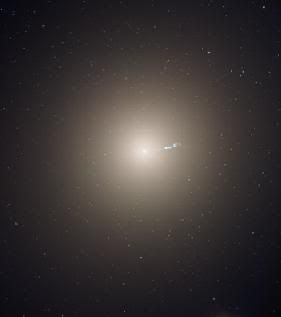|
|
Post by glactus on Jun 13, 2009 22:07:46 GMT
 Messier 87 M87 is a giant elliptical galaxy at the dynamical center of the nearby Virgo cluster and is one of the strongest radio sources in the sky. Discovered by Charles Messier in 1881, this monster is one of the most remarkable objects in the sky. Statistics: position : The constellation of Virgo Distance from Earth : 55 million light years. Magnitude: 8.6 Diameter: 120,000 + light years Number of stars: several trillion Also known as NGC 4486. M87 is too distant for Hubble to discern individual stars. The dozens of star-like points swarming about this massive galactic structure are, instead, themselves clusters of hundreds of thousands of stars each. An estimated 15,000 globular clusters formed very early in the history of this galaxy and are older than the second generation of stars, which huddle closer to the center of the galaxy. Streaming out from the center of tM87 like a cosmic searchlight is one of nature's most amazing phenomena - a jet of electrons and other sub-atomic particles traveling at nearly the speed of light and powered by the central super massive black hole of the galaxy. In this NASA Hubble Space Telescope image, the blue of the jet contrasts with the yellow glow from the combined light of billions of unseen stars and the yellow, point-like globular clusters that make up this gigantic structure.  Credit: NASA, ESA, and the Hubble Heritage Team (STScI/AURA) hubblesite.org/gallery/album/pr2008030fAcknowledgment: P. Cote (Herzberg Institute of Astrophysics) and E. Baltz (Stanford University) |
|
|
|
Post by Andy Mac on Jun 14, 2009 8:09:05 GMT
The jet shows up well in there but I have always found this galaxy a bit bland to image & observe.
|
|